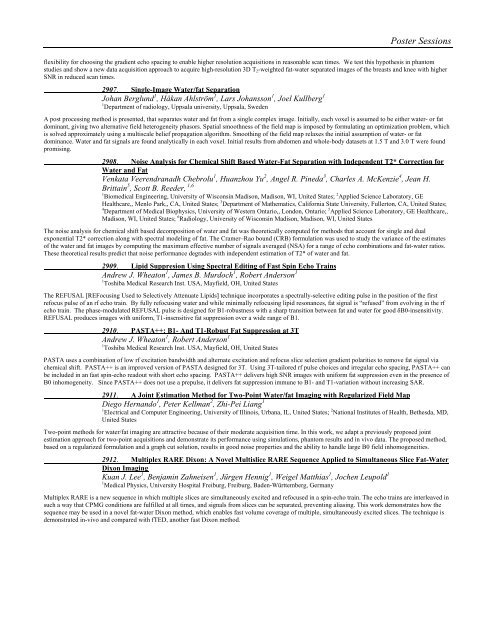TRADITIONAL POSTER - ismrm
TRADITIONAL POSTER - ismrm
TRADITIONAL POSTER - ismrm
You also want an ePaper? Increase the reach of your titles
YUMPU automatically turns print PDFs into web optimized ePapers that Google loves.
Poster Sessions<br />
flexibility for choosing the gradient echo spacing to enable higher resolution acquisitions in reasonable scan times. We test this hypothesis in phantom<br />
studies and show a new data acquisition approach to acquire high-resolution 3D T 2 -weighted fat-water separated images of the breasts and knee with higher<br />
SNR in reduced scan times.<br />
2907. Single-Image Water/fat Separation<br />
Johan Berglund 1 , Håkan Ahlström 1 , Lars Johansson 1 , Joel Kullberg 1<br />
1 Department of radiology, Uppsala university, Uppsala, Sweden<br />
A post processing method is presented, that separates water and fat from a single complex image. Initially, each voxel is assumed to be either water- or fat<br />
dominant, giving two alternative field heterogeneity phasors. Spatial smoothness of the field map is imposed by formulating an optimization problem, which<br />
is solved approximately using a multiscale belief propagation algorithm. Smoothing of the field map relaxes the initial assumption of water- or fat<br />
dominance. Water and fat signals are found analytically in each voxel. Initial results from abdomen and whole-body datasets at 1.5 T and 3.0 T were found<br />
promising.<br />
2908. Noise Analysis for Chemical Shift Based Water-Fat Separation with Independent T2* Correction for<br />
Water and Fat<br />
Venkata Veerendranadh Chebrolu 1 , Huanzhou Yu 2 , Angel R. Pineda 3 , Charles A. McKenzie 4 , Jean H.<br />
Brittain 5 , Scott B. Reeder, 1,6<br />
1 Biomedical Engineering, University of Wisconsin Madison, Madison, WI, United States; 2 Applied Science Laboratory, GE<br />
Healthcare,, Menlo Park,, CA, United States; 3 Department of Mathematics, California State University, Fullerton, CA, United States;<br />
4 Department of Medical Biophysics, University of Western Ontario,, London, Ontario; 5 Applied Science Laboratory, GE Healthcare,,<br />
Madison, WI, United States; 6 Radiology, University of Wisconsin Madison, Madison, WI, United States<br />
The noise analysis for chemical shift based decomposition of water and fat was theoretically computed for methods that account for single and dual<br />
exponential T2* correction along with spectral modeling of fat. The Cramer–Rao bound (CRB) formulation was used to study the variance of the estimates<br />
of the water and fat images by computing the maximum effective number of signals averaged (NSA) for a range of echo combinations and fat-water ratios.<br />
These theoretical results predict that noise performance degrades with independent estimation of T2* of water and fat.<br />
2909. Lipid Suppresion Using Spectral Editing of Fast Spin Echo Trains<br />
Andrew J. Wheaton 1 , James B. Murdoch 1 , Robert Anderson 1<br />
1 Toshiba Medical Research Inst. USA, Mayfield, OH, United States<br />
The REFUSAL [REFocusing Used to Selectively Attenuate Lipids] technique incorporates a spectrally-selective editing pulse in the position of the first<br />
refocus pulse of an rf echo train. By fully refocusing water and while minimally refocusing lipid resonances, fat signal is “refused” from evolving in the rf<br />
echo train. The phase-modulated REFUSAL pulse is designed for B1-robustness with a sharp transition between fat and water for good δB0-insensitivity.<br />
REFUSAL produces images with uniform, T1-insensitive fat suppression over a wide range of B1.<br />
2910. PASTA++: B1- And T1-Robust Fat Suppression at 3T<br />
Andrew J. Wheaton 1 , Robert Anderson 1<br />
1 Toshiba Medical Research Inst. USA, Mayfield, OH, United States<br />
PASTA uses a combination of low rf excitation bandwidth and alternate excitation and refocus slice selection gradient polarities to remove fat signal via<br />
chemical shift. PASTA++ is an improved version of PASTA designed for 3T. Using 3T-tailored rf pulse choices and irregular echo spacing, PASTA++ can<br />
be included in an fast spin-echo readout with short echo spacing. PASTA++ delivers high SNR images with uniform fat suppression even in the presence of<br />
B0 inhomogeneity. Since PASTA++ does not use a prepulse, it delivers fat suppression immune to B1- and T1-variation without increasing SAR.<br />
2911. A Joint Estimation Method for Two-Point Water/fat Imaging with Regularized Field Map<br />
Diego Hernando 1 , Peter Kellman 2 , Zhi-Pei Liang 1<br />
1 Electrical and Computer Engineering, University of Illinois, Urbana, IL, United States; 2 National Institutes of Health, Bethesda, MD,<br />
United States<br />
Two-point methods for water/fat imaging are attractive because of their moderate acquisition time. In this work, we adapt a previously proposed joint<br />
estimation approach for two-point acquisitions and demonstrate its performance using simulations, phantom results and in vivo data. The proposed method,<br />
based on a regularized formulation and a graph cut solution, results in good noise properties and the ability to handle large B0 field inhomogeneities.<br />
2912. Multiplex RARE Dixon: A Novel Multislice RARE Sequence Applied to Simultaneous Slice Fat-Water<br />
Dixon Imaging<br />
Kuan J. Lee 1 , Benjamin Zahneisen 1 , Jürgen Hennig 1 , Weigel Matthias 1 , Jochen Leupold 1<br />
1 Medical Physics, University Hospital Freiburg, Freiburg, Baden-Württemberg, Germany<br />
Multiplex RARE is a new sequence in which multiple slices are simultaneously excited and refocused in a spin-echo train. The echo trains are interleaved in<br />
such a way that CPMG conditions are fulfilled at all times, and signals from slices can be separated, preventing aliasing. This work demonstrates how the<br />
sequence may be used in a novel fat-water Dixon method, which enables fast volume coverage of multiple, simultaneously excited slices. The technique is<br />
demonstrated in-vivo and compared with fTED, another fast Dixon method.















